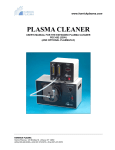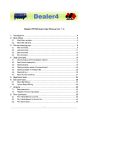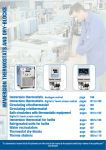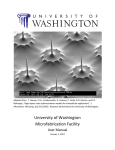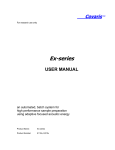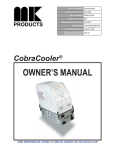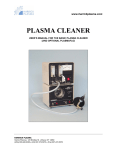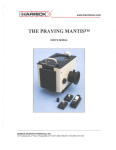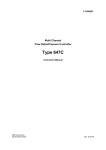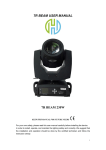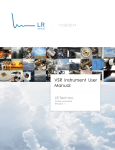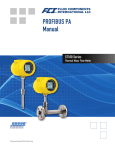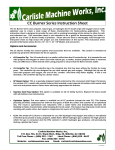Download HIGH TEMPERATURE REACTION CHAMBER
Transcript
www.harricksci.com HIGH TEMPERATURE REACTION CHAMBER USER’S MANUAL HARRICK SCIENTIFIC PRODUCTS, INC. 141 Tompkins Ave, 2nd floor • Pleasantville, NY 10570 • (800) 248-3847 • FAX (914) 747-7209 TABLE OF CONTENTS General Information Unpacking .................................................................................................................................... Technical Support ........................................................................................................................ Feedback ..................................................................................................................................... 1 1 1 About the High Temperature Reaction Chamber ......................................... 2 Installation and Alignment Getting Ready .............................................................................................................................. Window Installation ...................................................................................................................... Dome Installation ......................................................................................................................... Installing the HVC ........................................................................................................................ Fluid/Electrical Connections ........................................................................................................ 3 4 5 6 7 Operation Collecting the Background/Baseline Spectrum ........................................................................... Sample Spectrum ........................................................................................................................ 8 9 Options Cooling Cartridge.......................................................................................................................... 10 Purge Shield ................................................................................................................................. 12 HVC Maintenance Leak Checking ............................................................................................................................. Cleaning the HVC ........................................................................................................................ Replacing the O-rings .................................................................................................................. Replacing the Heater and/or Thermocouple ................................................................................ 14 14 14 15 Appendix Optional and Replacement Parts ................................................................................................ 16 HVC-M GENERAL INFORMATION UNPACKING Before installing the High Temperature Reaction Chamber make sure all the parts on the included check list are present. If any parts are missing or damaged, contact Harrick Scientific immediately. TECHNICAL SUPPORT For additional information please contact our Technical Support Center at 800-248-3847 between 9 a.m. and 5 p.m. EST; or e-mail your questions to: [email protected] FEEDBACK Your comments and suggestions are welcome. Please send them to: Harrick Scientific Products, Inc. PO Box 277 141 Tompkins Ave, 2nd floor Pleasantville, NY 10570 Phone: 800-248-3847; Fax: 914-747-7209 E-mail: [email protected] Web: www.harricksci.com 1 of 16 ABOUT THE HVC ABOUT THE HIGH TEMPERATURE REACTION CHAMBER (HVC) The HVC is designed for operation up to 910°C under vacuum (the lifetime of the heater is significantly reduced at temperatures above 450°C). The pressure range is from high vacuum to pressures up to 3.44MPa or 25.8 ktorr (the high pressure dome is required for pressures above 133 μPa or 1 ktorr). At higher pressures, the maximum operating temperature may be lower. The HVC is made of chemically resistant 316 stainless steel. Within the chamber is a temperature-controlled sample stage with integral sample cup. This stage incorporates a cartridge heater and a thermocouple. It is thermally isolated from the outer chamber wall. A water-cooling jacket controls the temperature of the outer surface of the chamber and windows during high or low temperature operation. The reaction chamber has three gas ports for evacuating, pressurizing or flowing gas through the sample. These ports are equipped with 1/4” VCO fittings. One of the ports leads directly under the sample cup; the other two lead into the sides of the chamber. The chamber is enclosed with a dome with three windows, two for the spectrometer radiation to enter and exit the chamber and the third for viewing, illuminating, or irradiating the sample. This enables the use of the reaction chambers for photochemical studies. For IR operation the standard material for the observation window is UV quartz and KBr for the other two windows. For UV-VIS operation the standard material for all three windows is UV quartz. CAUTION: Parts for the high pressure and low pressure domes should not be exchanged. The high pressure domes undergo high pressure testing and are guaranteed to work under the rated pressure. 2 of 16 INSTALLATION AND ALIGNMENT GETTING READY Before installing the High Temperature Reaction Chamber (HVC) familiarize yourself with it by referring to the drawing of the HVC found below (Figure 1). HVC Dome Gas Inlet/Outlet Gas Outlet Mounting pins (2) Thermocouple Connector Cooling Ports Gas Inlet/Outlet Heater Connector Heater Access Hole Figure 1 • The High Temperature Reaction Chamber HVC 3 of 16 INSTALLATION AND ALIGNMENT WINDOW INSTALLATION If the windows are not already installed or need to be cleaned or changed follow the steps below (Figure 2). NOTE: The observation window is the window that is located between the two semicircular indentations on the rim of the dome. • Insert an o-ring in one of the window ports. • Hold the retaining ring upside-down and place a PTFE washer inside. • Then carefully place a window on top of the PTFE washer. • Hold the retaining ring so that it continues to retain the window and thread it into the window port. • Tighten to secure the window in place using the tool provided for tightening and loosening the retaining rings. • Repeat these steps until all three windows are installed. NOTE: Be careful not to touch the windows during installation. Retaining Ring Window Dome PTFE Washer O-Ring Semicircular Indentation (2) Figure 2 • Installing the HVC Dome Windows 4 of 16 INSTALLATION AND ALIGNMENT DOME INSTALLATION Although it is not necessary to install the dome until later, it is recommended to become familiar with the procedure before proceeding to the next step. • Prior to installation of the dome make sure that the o-ring and groove on the bottom of the dome are clean and free of dust. • Retract the retaining plates on the HVC as far as possible. • Install the dome making sure that the orientation slot on the dome engages the orientation pin on the HVC (Figure 3). • Slide the retaining plates all the way over the rim of the dome. • Tighten the retaining plate screws to secure the dome. Orientation slot Retaining Plate Screws (4) Orientation pin Retaining Plate (2) Figure 3 • Installing the HVC Dome 5 of 16 INSTALLATION AND ALIGNMENT INSTALLING THE HVC Before installing the HVC in the Praying Mantis™, make sure that the Praying Mantis™ is aligned in the spectrometer. • Unscrew the thumbscrew on the top plate of the Praying Mantis™. • Carefully swing the top plate of the Praying Mantis™ out of the way. • Grasp the sample stage (Figure 4) and unscrew its mounting screw. • Slide the sample stage slightly to the left to dislocate its mounting pins. • Remove the sample stage. • Locate the mounting pins on the side of the HVC in the pin holes where the sample stage was located. • Reinstall and tighten the sample stage mounting screw. Mounting Screw Sample stage Mounting Pins (2) Figure 4 • Installing the HVC 6 of 16 INSTALLATION AND ALIGNMENT Gas Inlet/Outlet Gas Outlet Thermocouple Cooling Ports Heater Gas Inlet/Outlet Figure 5 • The HVC Installed • FLUID / ELECTRICAL CONNECTIONS NOTE: If temperature control is desired, connect the thermocouple and the heater (Figure 5) to a suitable temperature controller. • If the HVC is to be operated at temperatures above 100°C, use 1/4” tubing to connect the two cooling ports (see Figure 5) to a water inlet/outlet or a coolant circulator. If needed, use a hose clamp to secure the tubing to the barbed fitting. • If vacuum is desired, connect the gas outlet (1/4” VCO fitting, see Figure 5) to a vacuum pump or other source of vacuum using 3/8” I.D. vacuum tubing. Seal off the two gas inlet/outlet ports. • If reaction or process gas/es are to be passed through the sample, connect the gas inlet/out ports (1/4” VCO fitting, see Figure 5) as needed to the gas source/s. Connect the gas outlet and seal off any unused gas ports. • If reaction or process gas/es are to be passed over the sample, seal off the gas outlet. Connect one of the gas inlet/outlet ports to the gas source and the other as the outlet. Operation above 800ºC increases the thermal stress on the o-rings and windows. Be sure to check their condition regularly during high temperature operation. Continued operation at or near the high temperature limit of the cell will reduce the lifetime of the heater. CAUTION: Do not overtighten the VCO fittings. These are o-ring sealed fittings and they only need to be finger-tight to seal. If this is not sufficient, inspect the o-ring and replace as needed. 7 of 16 OPERATION COLLECTING THE BACKGROUND/BASELINE SPECTRUM • • • • • • • • • Place a sample screen into the sample cup and locate the plastic overflow tray over the sample cup (Figure 6). Fill the sample cup with the reference material using the provided packing tool. Draw the straightedge across the top of the cup to level off the surface. Carefully remove the overflow tray. Install the dome on the HVC. Swing the Praying Mantis™ cover back into place and tighten the thumbscrew. Set the temperature and pressure to desired operating conditions. Set the spectrometer to measure the “energy” on the detector for IR operation. For UV-VIS spectrometers with a micro switch, with the spectrometer in %T mode, hold the micro switch to activate the detector. Adjust the micrometer to maximize the signal on the detector. Collect the background spectrum. Sample Cup Overflow Tray Figure 6 • Filling the Cup NOTE: For best results, the reference material, a non-absorbing powder or rough surfaced solid, should be ground as finely as possible and packed tightly into the sample cup. 8 of 16 OPERATION • SAMPLE SPECTRUM • • • • • • • • • • NOTE: Restore the reference material to ambient conditions. Remove the dome. Empty the sample cup. This can be done by vacuuming out the reference sample or by removing the HVC from the Praying Mantis™ and dumping out the material. If needed, clean the sample cup. Fill the sample cup with the sample (follow procedure in the alignment section). Install the dome. Install the HVC into the Praying Mantis™ if it was removed to empty the sample cup. Swing the top plate back into place and tighten the thumbscrew. Restore the desired sampling conditions. Collect the sample spectrum. Empty the sample cup and clean it before running the next sample. For best results, use powdered samples in low concentration, diluting as needed with a non-absorbing powder such as that used for the reference. 9 of 16 OPTIONS ABOUT THE COOLING CARTRIDGE This optional cooling cartridge is designed to slide into the HVC instead of the supplied heater for moderate heating or cooling of the sample. It readily connects to chillers or recirculators using ¼” ID tubing. INSTALLATION • REMOVING THE HEATER • • • • • • • Remove the HVC from the Praying Mantis™ if it is installed. Use a 3/32 ball driver to unfasten the screw in the mounting block on the side of the HVC and remove the mounting block. Use a flat blade screwdriver to remove the screw and clamp on the back of the HVC that anchors the heater and thermocouple wire to the HVC. Push a small, blunt object through the heater access hole at the front of the HVC. Slide the heater out the back of the unit. Locate the mounting block on its pins with the thermocouple wire passing through the slot. Use a 3/32” hex-head driver to screw the mounting block back onto the side of the HVC. Use the new thermocouple (TC) clamp provided to re-secure the thermocouple wire. Mounting Block Screw Clamp Clamping Screw Figure 7 • Removing the Heating Cartridge 10 of 16 OPTIONS • • INSTALLING THE COOLING CARTRIDGE Slide it into the HVC until it hits the stop. Use a 1/16” hex-head driver to clamp the cooling cartridge in place as shown using, the clamp and screw provided. TC Clamp Cooing Cartridge Screw TC Clamping Screw Clamp Figure 8 • Installing the Cooling Cartridge • • Install the HVC in the Praying Mantis™ and install it into the spectrometer. Connect ¼” ID tubing from the barbed fittings to the chiller or recirculator. Barbed Fittings (2) Figure 9 • Cooling Cartridge Installed NOTE: There is a temperature differential between the set temperature of the chiller or recirculator and the sample cup due to thermal losses through the tubes, etc. Use the HVC thermocouple to monitor this differential and fine-tune the set temperature as needed. 11 of 16 OPTIONS ABOUT THE PURGE SHIELD This optional purge shield slips into the Praying Mantis to improve the purge sealing around the front of the HVC. • INSTALLATION • • • • Unscrew the thumbscrew on the top plate of the Praying Mantis™. Carefully swing the top plate of the Praying Mantis™ out of the way. If the sampling stage or HVC is installed in the Praying Mantis™, unscrew the mounting screw and remove the sampling stage. Slide the purge shield into the Praying Mantis, directly behind the front of the accessory, as shown in Figure 10. Push the purge shield slider up to allow room for installation of the HVC. Purge Shield Slider Purge Shield Figure 10 • Removing the Heating Cartridge NOTE: The purge shield is transparent, allowing easy viewing of the sample. It is not, however, intended for use in conjunction with sample illumination through the observation window. 12 of 16 OPTIONS • • • • • Feed the HVC through the purge shield. Locate the mounting pins on the side of the HVC in the pin holes where the sample stage was located. Reinstall and tighten the sample stage mounting screw. Push the purge shield slider down to seal the front of the HVC. Continue setting up the HVC as described previously. Figure 11 • Removing the Heating Cartridge 13 of 16 HVC MAINTENANCE LEAK CHECKING The HVC has been carefully checked for leaks before shipment. However, each time the HVC is disassembled and reassembled, leaks may develop due to improper setting of the o-rings. If leaks occur, carefully inspect all o-rings and sealing surfaces for damage and contamination. Small leaks can be pinpointed using a Helium Leak Detector. Contact Harrick Scientific Products, Inc. for advice and/or repair information. CLEANING THE HVC To thoroughly clean the HVC follow the procedure below. • • • • • • • REPLACING THE O-RINGS Vacuum out the sample or remove the HVC from the Praying Mantis™, remove the dome, turn the HVC upside-down and dump out the sample. Use solvent to clean off the remaining sample. Unscrew the eight screws that secure the bottom cover of the HVC. Remove the bottom cover to reveal three access holes. Gingerly wipe or blow clean air through these holes to clean the interior of the HVC. When the interior is clean, make sure the o-rings on the bottom plate are clean and free of dirt. Re-install the bottom cover. The o-rings used by the HVC should be replaced periodically. The HVC has o-rings for sealing the windows, o-rings for sealing the access holes, o-rings on the fittings, and an o-ring to seal the dome to the HVC. 14 of 16 HVC MAINTENANCE REPLACING THE HEATER AND/OR THERMOCOUPLE To replace the HVC heater: • Remove the HVC from the Praying Mantis™ if it is installed. • Use a 3/32 ball driver to unscrew the screw in the mounting block on the side of the HVC and remove the mounting block. • Use a slotted screwdriver to remove the screw and clamp on the back of the HVC that anchors the heater and thermocouple wire to the HVC. • Grasp the heater wires firmly and slide the heater out. • If replacing the thermocouple, slide the old thermocouple out of the HVC. Then insert the new thermocouple into the small hole (see Figure 13) as far as it will go. • Slide the heater into the HVC until it hits the stop. Make sure that the heater and thermocouple are inserted completely into the body. • Position the mounting block onto the side of the HVC, feeding the three wires along the recess in the block. • Then use a 3/32 ball driver to secure the mounting block in place. • Reinstall the clamp to secure the wires to the back of the HVC. Mounting Block Screw Clamp Clamping Screw Figure 12 • Removing the Heating Cartridge and/or Thermocouple Thermocouple Hole Heater Hole Figure 13 • Installing the Heating Cartridge and/or Thermocouple 15 of 16 APPENDIX OPTIONAL PARTS Temperature Controller, 110V input, 24V output .................................................... Temperature Controller, 220V input, 24V output .................................................... RS-485 to USB Adapter for the Temperature Controller ........................................ Vacuum Pump, 110V .............................................................................................. Vacuum Pump, 220V .............................................................................................. High Pressure Dome for the HVC-DRP, ZnS Windows ......................................... High Pressure Dome for the HVC-DRP, ZnSe Windows ....................................... High Pressure Dome for the HVC-DRP, UV Quartz Windows ............................... ZnS Window for the HVC-DRP High Pressure Dome ............................................ ZnSe Window for the HVC-DRP High Pressure Dome .......................................... UV Quartz Window for the HVC-DRP High Pressure Dome .................................. UV Quartz Window for the Vacuum/Low Pressure Domes .................................... Si Window for the Vacuum/Low Pressure Domes .................................................. CaF2 Window for the Vacuum/Low Pressure Domes ............................................ ZnS Window for the Vacuum/Low Pressure Domes .............................................. ZnSe Window for the Vacuum/Low Pressure Domes ............................................ KBr Window for the Vacuum/Low Pressure Domes ............................................... Cooling Cartridge .................................................................................................... Purge Shield ........................................................................................................... ATC-024-3 ATC-024-4 ATC-USB-485 VPE-001 VPE-002 HVC-DWI-3 HVC-DWM-3 HVC-DWA-3 WID-U43 WMD-U43 WAD-U43 WAD-U23 WED-U23 WFD-U23 WID-U23 WMD-U23 WPD-U23 HVC-COL DRP-PDR REPLACEMENT PARTS Overflow tray, 11.0 mm ID ....................................................................................... Packing Tool ........................................................................................................... Screen Set, two each of three mesh sizes, 4.7 mm dia. ......................................... Screen Set, 150 x 150 mesh (6), 4.7 mm dia. ........................................................ Screen Set, 250 x 250 mesh (6), 4.7 mm dia. ......................................................... Screen Set, 400 x 400 mesh (6), 4.7 mm dia. ......................................................... K-Type Thermocouple ............................................................................................ Flex Mounting Plugs – Male ................................................................................... 1.00”x0.25” Cartridge Heater, 100W, 24V .............................................................. 24V Heater Assembly ............................................................................................. O-Ring (#10) for the VCO Fittings, Viton ................................................................ O-Ring (#10) for the VCO Fittings, Kalrez .............................................................. O-Ring (#16) for the Bottom Cover, Viton .............................................................. O-Ring (#16) for the Bottom Cover, Kalrez ............................................................ O-Ring (#23) for the Dome, Viton ........................................................................... O-Ring (#23) for the Dome, Kalrez ......................................................................... O-Ring (#13) for Windows of the Dome, Viton ....................................................... O-Ring (#13) for Windows of the Dome, Kalrez .................................................... PTFE Washer for the Windows .............................................................................. UV Quartz Window for the Vacuum/Low Pressure Domes .................................... UV Quartz Window for the HVC-DRP High Pressure Dome .................................. KBr Window for the Vacuum/Low Pressure Domes ............................................... 16 of 16 116-989 116-836 116-990 116-990-1S 116-990-2S 116-990-3S 008-144 008-266 HTRS-26 HVC-HT4 ORV-010 ORK-010 ORV-016 ORK-016 ORV-023 ORK-023 ORV-013 ORK-013 116-429 WAD-U23 WAD-U43 WPD-U23 Manual Part No. HVC-M-09 ©2013 Harrick Scientific Products, Inc.






















